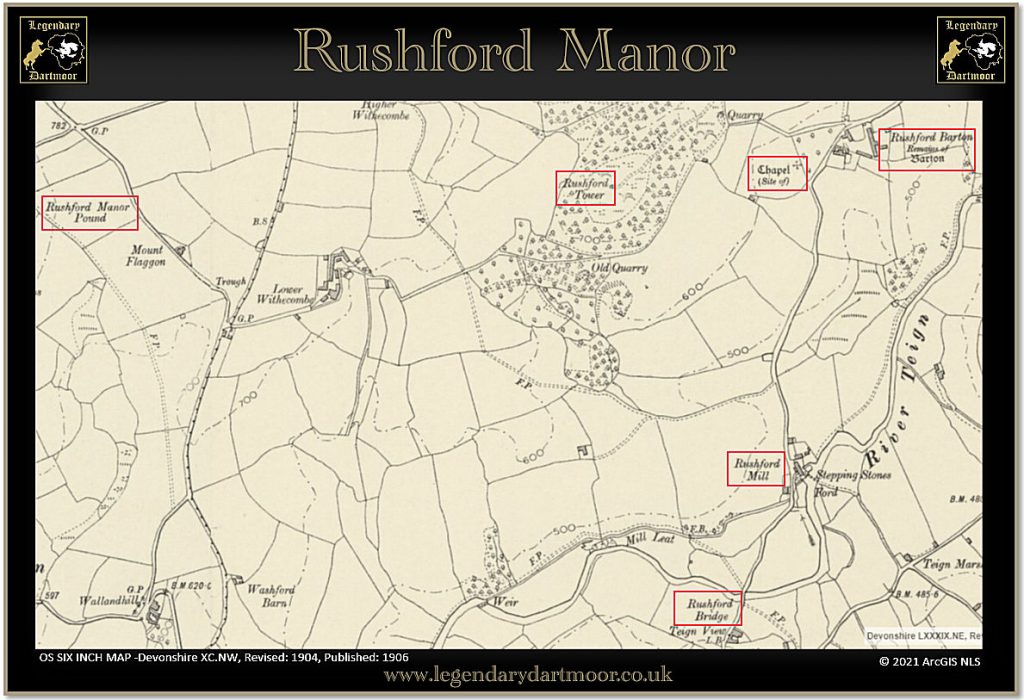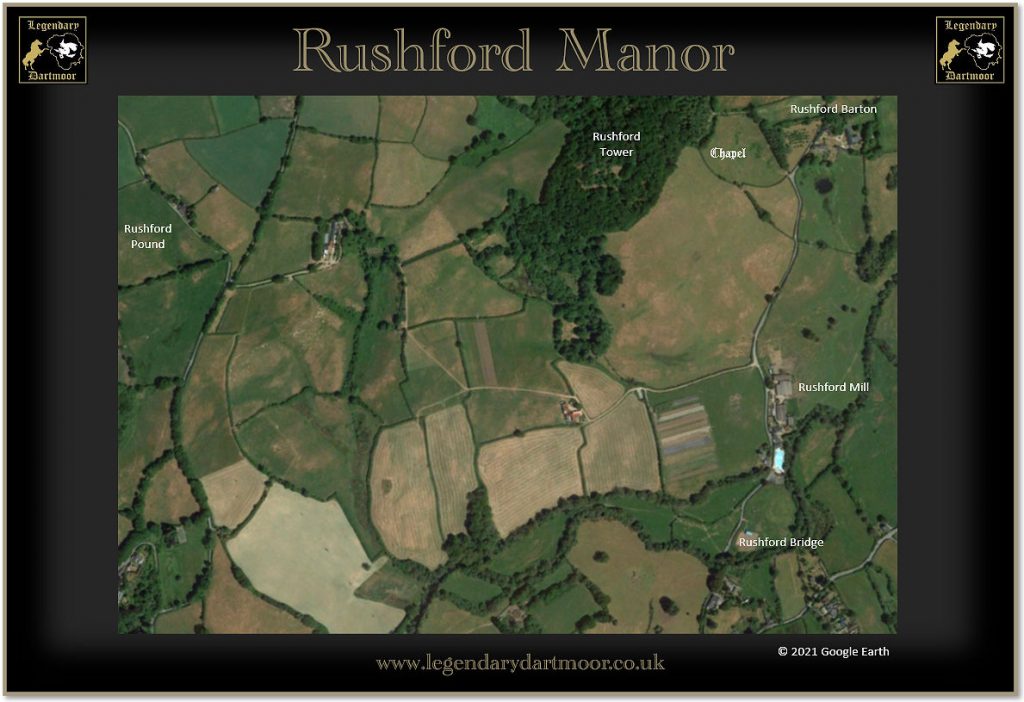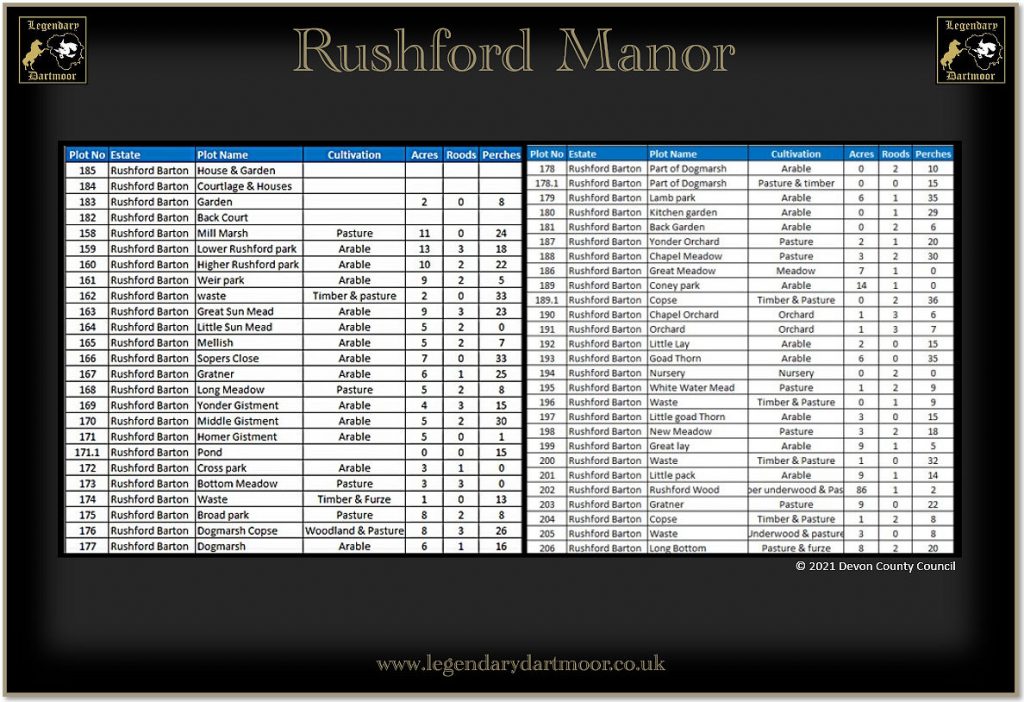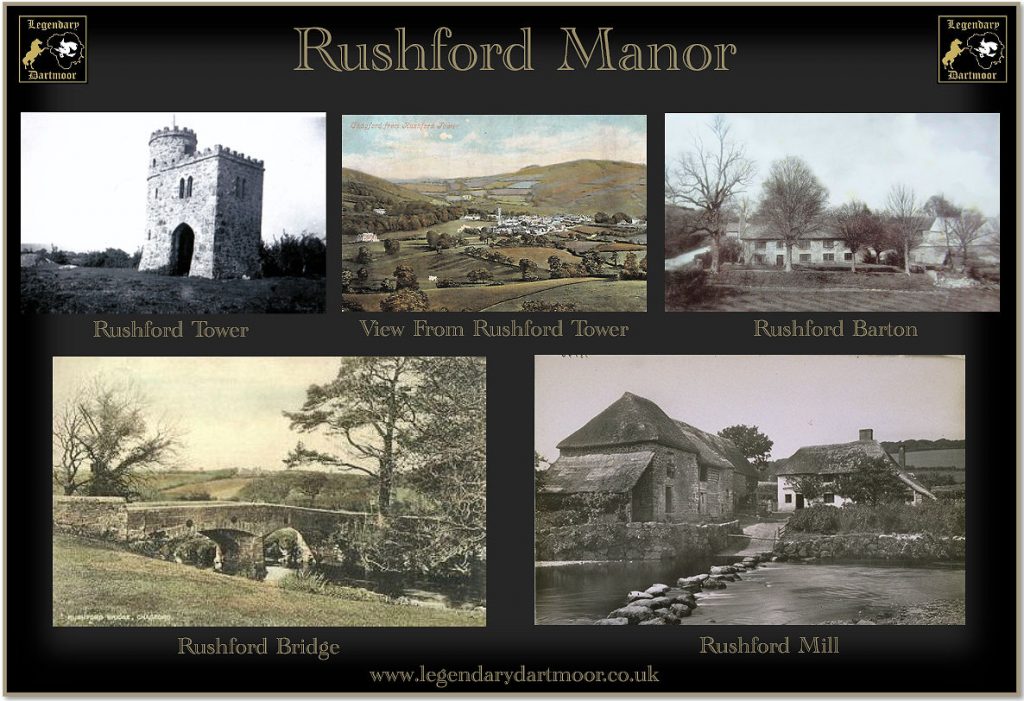
There were many medieval manors on Dartmoor and Rushford is one of those timeless places where it seems time has stood still, although most of the original structures have long gone there are still vestiges that appear to last throughout time. You can literally walk in the foot steps, or at least stepping stones that for centuries travellers have passed across as they went about their daily lives.The earliest mention of Rushford is that for Risford in the Domesday book of 1086, here the translated entry states:“Eadwig holds Rushford from Baldwin, He himself held it TRE (Tempore Regis Edwardi – in the time of King Edward or before the 1066 invasion) and it paid geld for 1 hide. There is land for 5 ploughs. In demesne is 1 plough, with 1 slave; and 8 villans and 5 bordars with 3 ploughs. There are 5 acres of meadow, and 4 acres of pasture and 4 acres of scrubland, Formerly, as now worth 30s”. So in this year Rushford was called ‘Risford’ and probably centred on what now is Rushford Barton, Rushford Mill, Rushford Wood, and Higher and Lower Withecombe, it is likely that these lands formed a manor previous to the later Rushford Barton. The place-name etymology of the place according to the Place-Name Society, p. 425, is: Risford – 1086 (Domesday Book) – Risford – 1242 ( Book of Fees) – Rissheford – 1292 (Assize Rolls) – Russheford – 1504 (Calendar of Inquisitions) Both Rushford and Rushford Mill appear on Benjamin Donn’s map of 1765. The OS map of 1888 shows the barton, mill and outlying farms as separate identities – see map below.
Rushford Manor (Barton) – The manor of Rushford belonged to a family called de Risford until around the late 1100’s when the heiress married a man named Hore. There is a record dating to 1249 in which a John Furland complained to the justices that the lord of Rushford had deprived him of his grazing on the fields after harvest, this presentment was upheld on the lord had to restore seisin (the possession of such an estate in land as was anciently thought worthy to be held by a free man) and pay compensation, Finberg, p. 271. During the period between 1300 and 1400 a family called Monke held the manor from the Hore’s. who returned by Tudor times. It was the Hore family who probably built the Tudor Barton of Rushford which was located just to the north of the old Norman manor house. The building was said to have been described as a “fine Tudor barton”. By the early 1800s the estate was owned by Hooper family and in 1816 a notice appeared in various newspapers offering to let from the following Lady Day Withecombe Cottage’ which consisted of; a parlour, sitting room, four bedrooms, kitchen, good gardens well stocked with fruit trees, stabling for 4 horses, outbuildings, with hunting and fishing available over the extensive manor opposite. An identical notice appeared in the April of 1823 this time with immediate effect, similarly to be let again in again in 1828, 1829, 1830. On the 29th of June 1849 the estate was to be sold at auction. It consisted of; “a good farmhouse and convenient outbuildings, 322 acres of arable, meadow, pasture, orchard, and woodland, the mills consisting of dwelling house, mill house, and machinery, 18 acres of meadow and pasture.” – The Exeter & Plymouth Gazette, June 16th 1849. As with any estate there were various commercial aspects to Rushford and timber was a main one. According to the Tithe Apportionment of 1840 there was just over 95 acres of woodland and copses along with around 7 acres of woodland growing in ‘wastes’. In 1815 and advert appeared in many of the local newspapers offering 340 oak trees and 36 ash trees for sale, all with their tops and bark. The Chagford Tithe Apportionment of 1840 gives a glimpse of Rushford Barton as can be seen below. At that time the whole estate consisted of some 306 acres comprising of arable land , pasture land, meadows, orchards, and woodlands.
On September 28th, 1855 the estate was again up for auction – “comprising of comfortable farmhouse, farm yard, farm buildings, labourers’ cottages, 311 acres of arable, pasture, meadow, orchard and woodland, a corn mill driving three pairs of stones with miller’s house and several enclosures of rich meadowland – in the occupation of Mr. Tarr at a moderate rental of £44 10s. per annum.” – The Western Times, September 22nd 1855. In 1856 the whole estate of Rushford was bought by the then rector of Chagford George Hayter Hames, this included Rushford Barton, Rushford Mill, and Rushford Wood. By 1901 Rushford Estate had been let to a Mr. E. Scott James and in the August of that year an auction on behalf of Hayter Hames was held at which; “200 sheep and lambs, 30 bullocks, 8 horses and colt, poultry imp0lements and household furniture,” were amongst the lots. – South Devon Advertiser, August 31st, 1901. It is evident from the adverts which appeared in the local press for various members of staff that at this time the main concerns at the farm were dairying, sheep, poultry, and potato cultivation. In the September of 1905 a notice of a forthcoming auction at Rushford Barton was to be held. It read; “comprising of 30 wether hogs, 1 Dartmoor ram, 4 cows in milk, 1 heifer in calf, 1 barrener in milk, 2 fat heifers, 4 steers, 3 rearing calves, 1 grey cart gelding 15.2 h.h. good in all harness, 1 brown mare 15.2 h.h. good huntress carried a lady good in harness, 1 black pony gelding 13.2 h.h. rising 5 quite to ride and drive good mover, 2 Dartmoor ponies rising 4 years, 1 x Exmoor pony in foal, sow and farrow, mowing machine, hay tedder, horse rake, plough, drags, chain harrow, hay collector, Coster cart by Bristol Wagon Works, Governess cars, pony trap, harnesses, 3 Hackney saddles.” – The Western Times, September 22nd, 1905. This appeared to be a sale of surplus stock and equipment as Scott James continued farming at Rushford Barton until the February of 1910 when an notice of auction appeared; “Important sale of 60 bullocks, 70 couples ewes and lambs, 30 hogs, horses and pigs, instructed by E. Scott James who is declining farming.” – The Western Times, February 11th 1910. In the March of 1910 a more detailed auction notice appeared. “BULLOCKS – 7 cows and calves, 4 cows in full milk, 2 cows in milk and in calf, 2 heifers and calves, 2 heifers in calf, 2 barreners, 5 steers 2 years old, 8 heifers 2 years old, 9 yearling heifers, 8 yearling steers, 5 heifer calves, pedigree bull “Lord Tom”. SHEEP – 60 couples improved Dartmoor ewes and lambs, 30 ewe and wether hogs, 1 ram. HORSES – “Madam” bay cart mare, 15.2 h.h. 9 years, quiet in all work, Bay cart mare, 15.2 h.h. quite in saddle and harness, very fast and a good jumper. Bay mare, 14 h.h. 5 years old by “Old Sam”, broken to saddle would make a good boy’s hunter, 1 cart horse, 2 years old, by “Rangitira”, 1 yearling colt by Rangitira, 2 smart yearling fillies, out of good pony mares, one by “Rockaway”. PIGS – 2 breeding sows (1 in farrow), 11 good slips. ” – The Western Times, March 10th 1910. It was also noted that the cattle were all pedigree South Devons and the sheep were Improved Dartmoors which today are known as Greyface Dartmoors. By 1913 the farm was in the tenancy of a Mr. J.J. Nickels who ran the place with his sister as housekeeper.
On the morning of September 20th 1913 Miss Nickels noticed that the kitchen stove was not drawing properly despite having the flues recently cleaned. On going outside she saw that the smoke was not coming out of the chimney but billowing out from between the granite chimney and the thatch roof. Having summonsed her brother they then noticed that the same was happening at the other chimney some 50 feet at the other end of the roof. Immediately the Chagford Fire Brigade were called In the meantime Miss Nickels went to nearby Sandy Park to muster further help. Soon locals began appearing and they began removing furniture from the house. Fortunately Rushford Barton had a large pond in its grounds from which the fire brigade drew the water and began to fight the fire. Sadly despite their brave efforts the roof fell in after about an hour by which time the fire had spread throughout the house leaving just the thick charred walls and the three granite chimneys standing. Afterwards it was thought that the fire was caused by a defective chimney and that it must have been smouldering for days before actually catching alight when the flames were fanned by a stiff wind blowing on that fateful morning. Luckily the house and furniture were insured by the Royal Insurance Company. By the following October the local press were carrying invitations from Mr. C. G. Hayter-Hames to tender for the restoration work.
Once the restoration work was completed things soon got back to normal for the Nickels’ and non the 21st of April 1921 a surplus stock auction was to be held. The lots comprised of; “109 registered Dartmoor lambs, 22 well-bred South Devon bullocks (2 pedigree) , 33 pedigree Long Black Pigs and a mare in foal.” – The Exeter & Plymouth Gazette, April 1st 1921. In the May of 1922 for some reason the Nickels’ decided to give up the tenancy of Rushford as the following notice shows; “To let by tender from Michaelmas (September 29th)… comprising a recently-built genteel and commodious dwelling house, containing 3 receptions, 7 bed, bath (h. and c.), all usual offices; ample and conveniently arranged farm buildings and about 128 acres of choice meadow, pasture, orchard and arable land, together with the grazing of Rushford Wood adjoining about 92 acres.” – The Exeter & Plymouth Gazette, May 12th 1922. Come the next August another notice for auction appeared for; “66 registered Dartmoor sheep, 34 well-bred South Devon bullocks, 21 pedigree Long Black Pigs, cart colt and 4 acres potatoes in ground.” – The Exeter & Plymouth Gazette, August 4th 1922. As Michaelmas Day approached the following was to be auctioned on the 26th of September 1922; “4 cart horses, 124 head of pure-bred Speckled Sussex Poultry, farm implements, cider, apples, household furniture etc.” – The Western Times, September 15th 1922. This was just a ‘teaser’ ad for on the 22nd of September the full catalogue appeared which read; “Horses – “Bob” light bay gelding, 15.2 h.h. rising 5 years, “Prince” bay gelding 17 h.h., “Boxer” dark bay gelding 15.2 h.h. rising 6 years, “Triton” chestnut gelding 15.2 h.h., all quiet and reliable in all farm gears. IMPLEMENTS – Wain waggon with lades and sideboards, Butt Waggon and lades, 2 butt carts, varnished dog cart, three wheel butt, 3 complete sets breeching harness, 1 ditto fore-horse harness, trap harness, collars and bridles, plough hames and chains, drafts and wippers, “Bamford’s” combined mower and reaper, “Davy Sleep” hay tedder, nearly new, “Bamford” swath tuner, hay pitcher and pole, hay sweep, “Powell” potato digger, “Huxtable Syracuse and cut ploughs, three-row sidehill patent horse hoe, Potato banker with feet, complete scarifier, spring harrows, seed harrows, iron drags, stone and wood rollers, grass seed drill, reed comber, 2 turnip cutters, sheep rack and troughs, iron and wood pigs’ troughs, 100 hurdles, iron corn bin, 100 gallon oil tank with tap, bullock chains, 12 feeding tubs, empty cider hogshead and barrels, 2 pipes of excellent cider, jibbing pound kieves, funnel, wire netting, fencing wire, husbandry tools &c. POULTRY – 50 splendid pure-bred Speckled Sussex hens, 30 ditto pullets, 20 ditto young cockerels, 9 runner ducks, 2 drakes, 2 poultry houses, hen coops. APPLES IN ORCHARD – including some good eating and cooking varieties, with use of pound.” – The Western Times, September 22nd 1922. The next person to take on the lease was Fredrick Hoskin who suffered a serious injury in the January of 1925 whilst at a handsaw bench that resulted in him having his arm amputated, sadly he died in the July of that year. That same month the lease of the farm was once again up for tender, the next incumbent was Mr. F. G. Underhill who remained at the farm well into the 1950s. He was a noted agriculturalist and parish councilor.
Rushford Chapel – There was once a chapel to the west of Rushford Manor which according to English Heritage records was licensed in 1329, by 1630 it was a ruin and then demolished between the 17th and 18th centuries. Hayter-Haymes, p.35 further adds that it was a monk called William le Moyne who was given the right to the chapel by Bishop Grandisson. Major Hore finally demolished the structure in the 18th century as in his opinion it obscured the views from his house. The stones were used to rebuild his garden and orchard walls and are evident today. The aerial map above of the area does show the feint outline of a rectangular building near to the site of where the chapel was said to have been, this could well be the last vestiges of the structure?
Rushford Mill – Was the original manorial corn mill and it is thought that the stepping stones which spanned the river Teign were at one time the main crossing point from the manor to Chagford. It was normal for each manor to have its own grinding mill and then everybody who was affiliated to that manor were compelled to bring their corn for grinding be it for flour or grist (cattle feed), Harris, 1992, p.118. In many places the miller was one of the least popular people as he was seen as taking unfair profit from the fact that the villagers had to use him. In the Lutterell Psalter the miller is typically depicted as an ugly man looming over an old, helpless woman along with a fierce guard dog. For more information on Rushford Mill see the Legendary Dartmoor page – HERE.
Rushford Manor Pound – Although the exact location is unknown the OS 25″ map of 1886 places it in an enclosure directly opposite the old Mount Flaggon farmstead.
Rushford Bridge – Was estimated to originally have been 7½ feet wide and was later widened to its present width, much of the original structure including the twin arches were kept, Henderson & Jervoise, p.40. There is an entry in the Chagford’s churchwarden accounts for 1539 for a payment of 10s for repairs to Rushford Bridge. In the August of 1816 the County Clerk of the Peace was inviting tenders to widen Rushford Bridge and all the plans and specifications could be seen at the house of the Reverend G. Gregory of Dunsford.
The old bridge appears in Eden Phillpott’s novel ‘Children of the Mist -“Already sunset fires had waned; but the high top of the fir that crowned Rushford Bridge still glowed with a great light on its red bark, and uprising Whiddon, where it lay afar off under the crown of Cranbrook, likewise shone out above the shadowed valley.” Eden Phillpotts, 1903. Children of the Mist, p.14.
Rushford Tower – To the southern end of Rushford Wood is what Knowling, pp. 7 – 8, describes as Dartmoor’s best-known follies. It consists of a single tower and a small castle-like structure, listed as a “small observation tower in the Victorian Gothic style”. Tradition has it that the building was built sometime between 1850 -1900 and that it was used as a ‘grandstand’ for women and children from which they watched the many shooting parties that were held in the woods. J. Ll. Warden Page in his book, ‘The Rivers of Devon, p.74, describes Rushford Tower as an, “modern antique tower”. This book was published in 1893 so perhaps if he describes it as being, “modern”, it could indicate a construction date towards the end of the 1800’s – please note Rushford Tower is on private land with no access rights! Crossing, 1990, p.275, draws attention to a strip of turf that lies to the north of Rushford Tower, this he says was known as the ‘bowling green’ on which was a rock basin known as the ‘punchbowl’. Today the tower is a Grade II listed building and the architectural details can be found on the Historic England webpage – HERE.
Notable Events at Rushford Manor. – The March of 1838 an article in the Exeter & Plymouth Gazette related how a respectable auctioneer from Exeter received a letter saying that the owner of Rushford Barton wished to sell all his livestock and dead stock, furniture and effects and could he come to value them as soon as possible. The next day the auctioneer along with his clerk left Exeter in a chaise and pair for Rushford. On arrival he met the son, William Hooper and explained that he had come to value the assets of the farm prior to sale. This came as bit of a shock to William who probably saw his future inheritance go under the hammer. He immediately fetched his father John who emphatically stated that nothing was for sale. The auctioneer explained that he had received a letter signed by John Hooper requesting his urgent attention. It was the politely explained to the poor auctioneer that it was all a hoax and he had been sent out on a ‘fool’s errand’. But as a small gesture of compensation both the auctioneer and his clerk were treated to a sumptuous lunch and all parted on good terms, the author of the letter was never discovered.
In the September of 1868 a young lady called Hammond who was staying at the Chagford rectory was nearing Rushford Bridge at around six o’ clock in the evening. Suddenly three men appeared and threatened her with violence if she did not hand over her watch and money. Bravely she insisted she had neither and luckily a noise was heard approaching in the distance and the three ruffians fled the scene. – The Exeter & Plymouth Gazette, September 25th 1868.
1869 – “On Saturday morning , about four o’clock, a fire broke out at Rushford Barton. It was first seen by Mr. Nichols of Sandy Park, who at the same time saw a man lurking about the spot. The engine of the Royal Insurance Company played upon the flames. Two hay ricks and a corn rick were burnt, and the thatch of an outhouse had to be torn off. The fire broke out a second time, after the engine had left, and had to be sent back.” – The Exeter & Plymouth Gazette, August 20th 1869.
In the June of 1896 an elderly man named Seaman left the Okehampton Union House and managed to hitch a ride on a passing waggon to Chagford. Unfortunately as they were descending the hill by Rushford Seaman lashed the horse with his stick which resulted in it bolting forward. This overturned the waggon throwing both men out of the front of it and the wheels rolled over Seaman killing him on the spot. – The Western Times, June 19th, 1896.
Following on from Seaman’s tragic death – “There is a saying often repeated that when the coroner crosses Chagford Bridge once he always does three times a year. He recently held an inquest on a man who was killed by falling from a waggon near Rushford Barton; the next may be on one or more persons killed by the capsizing of a vehicle at the end of the lane leading to Rushford Mill. If the bus horses were to swerve about a couple of feet from their ordinary track at this spot the top passengers would go down this lane no doubt to their deaths, and the Coroner’s jury would say the road ought to have been repaired when the Parish Council called attention to it some weeks ago. This spot is probably the narrowest and most dangerous piece of main road in the County.” – East & South Devon Advertiser, August 1st, 1896.
In the June of 1935 Devonshire was inundated with a disastrous plague of rabbits and at Rushford – “Mr. F. G. Underhill of Rushford Barton, Chagford, placed the damage done by rabbits around there at £1,000. He said he was unable to stock a six acre field of Meadow Grass since last December until this month because of the existence of rabbits, which ate all the herbage. It was necessary for him to engage a trapper, and in a week in one field adjoining the roadway he caught 173 rabbits. Since the winter months upward of a 1,000 have been caught at Rushford Barton.” – The Western Morning News, June 28th, 1935.
 AHE. 2004 Digital Domesday – Devon, CD-Rom, Alecto Historical Editions.
AHE. 2004 Digital Domesday – Devon, CD-Rom, Alecto Historical Editions.
Barber, C. 2002 Chagford of Yesteryear, Obelisk Publications, Exeter.
Barber, C. 1994 The Great Little Chagford Book, Obelisk Publications, Exeter.
Bound, T. 1995 Walks in the Chagford Countryside, Obelisk Publications, Exeter.
Cosford, J. & Rhodes, J. 1989 The Chagford Diary, Devon Books, Exeter.
Gover, J. E. B., Mawer, A. & Stenton, F. M. 1992 The Place Names of Devon, English Place-Name Society, Nottingham.
Haytor Hames, J. 1981 A History of Chagford, Philimore & Co., London/Chichester.
Harris, H. 1992 The Industrial Archaeology of Dartmoor, Peninsula Press, Newton Abbot.
Henderson, C. & Jervoise, E. 1938 Old Devon Bridges, Wheaton, Exeter.
Hoskins, W. G. & Finberg, H. P. R. 1952 Devonshire Studies, Jonathan Cape, London.
Knowling, P. 2002 Dartmoor Follies, Orchard Publications, Newton Abbot.
Page, Ll. W. 1893 The Rivers of Devon, Seeley & Co., London.
Phillpotts, E. 1942 Children of the Mist, Nelson & Sons, London
Rice, I. 2002 The Book of Chagford, Halsgrove Publishing, Tiverton.
 Legendary Dartmoor The many aspects past and present of Dartmoor
Legendary Dartmoor The many aspects past and present of Dartmoor





Who lives at the Rushford Barton house today?
(Private reply please)
Sorry, no idea.
hahaha “please note Rushford Tower is on private land with no access rights!” I have many memories of exploring up there, and many more memories of running away from angry farmers!
My father visited the Rushford Barton house in the mid-1980s and met a Haytor-Hames family member who was still living at the house. He took many photos of the property which I still have today. Many aspects of Norman construction are clearly visible which my Dad thoughtfully documented for me.
from abberleyhills@icloud.com
Tarr
and the Millers of Dartmoor
Our family name pervades some of the Mills in this and surrounding areas before moving further afield with the onset of Railway development.
It would be interesting for us to meet up with a local when we are in the area next time?
Best Wishes……Carleton Tarr
Many thanks for your site which shed light on a family mystery. I was going through my grandmother’s photo albums when I came across a set marked Rushford Barton June ’97 (as in 1897). Included were shots of the old farm buildings, various local landmarks (Spinster’s Rock), a shooting party (including my great grandfather) and “Farmer Nickel” who I surmise to be Mr. J.J. Nickels (in spite of the dates). There is also a photo of “The Farm Girl” who could be the Miss Nickels you refer to.
Happy to share if there is any interest.